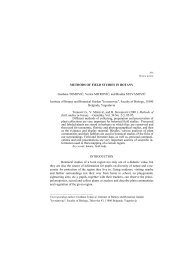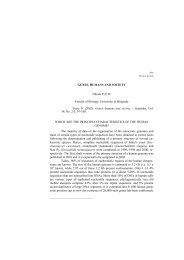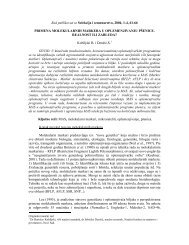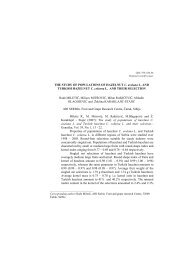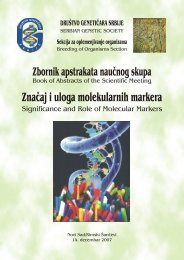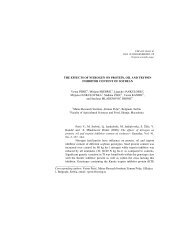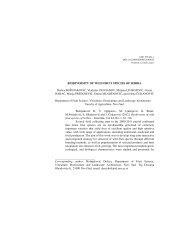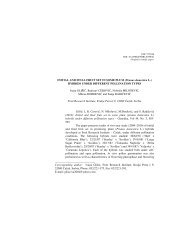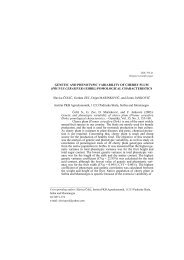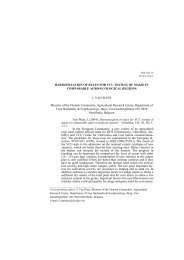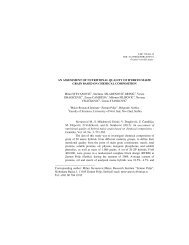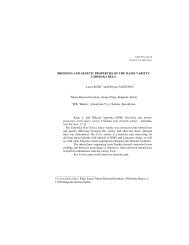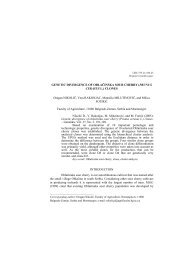Zbornik - Društvo genetičara Srbije
Zbornik - Društvo genetičara Srbije
Zbornik - Društvo genetičara Srbije
Create successful ePaper yourself
Turn your PDF publications into a flip-book with our unique Google optimized e-Paper software.
58 ZBORNIK ABSTRAKATA III KONGRESA GENETIÈARA SRBIJE II-Pos-3<br />
Subotica, 30. novembar - 4. decembar 2004.<br />
USPOSTAVLJANJE VEÆE EFIKASNOSTI TRANSFEKCIJE<br />
HUMANIH ÆELIJA U KULTURI<br />
Gordana Nikèeviæ, Nataša Kovaèeviæ-Grujièiæ, Isidora Petroviæ i Milena Stevanoviæ<br />
Institut za molekularnu genetiku and genetièko inenjerstvo, Beograd<br />
Transfer rekombinantnih gena u razlièite eukariotske æelije u kulturi je široko rasprostranjena<br />
metoda za prouèavanje genske ekspresije. Pošto je potreba za brzom, visoko<br />
efikasnom transfekcijom postala sve izraenija, razvijen je veliki broj produkata,<br />
ukljuèujuæi lipozome, nelipozomalne lipide, sintetièke polimere, i dr., koji omoguæavaju<br />
transport gena u æelije. Meðutim, problem kod veæine ovih, tzv. ne-viralnih agenasa je<br />
njihova niska efikasnost transfekcije.<br />
U cilju izuèavanja regulacije gena ukljuèenih u neuralnu diferencijaciju, bilo nam je<br />
neophodno da privremenom (transient) transfekcijom uvedemo rekombinantnu<br />
plazmidnu DNK u humanu embrionalno-karcinomsku æelijsku liniju (NT2/D1) sa<br />
visokom efikasnošæu. U tu svrhu, najpre smo testirali dva transfekciona sistema:<br />
LIPOFECTAMINE TM (Life Technologies) i EffecteneTM (QIAGEN) koristeæi pCH110<br />
eukariotski vektor koji sadri lacZ reporter gen.<br />
Rezultati našeg istraivanja pokazali su da za NT2/D1 i HeLa æelije (model sistem koji se<br />
èesto koristi kao kontrola u eksperimentima transfekcije), efikasnost transfekcije<br />
EffecteneTM reagensom, moe jednostavno biti uveæana dodavanjem 1.5-3 puta veæe<br />
kolièine plazmidne DNK od one koja je preporuèena od strane proizvoðaèa. Koristeæi<br />
LIPOFECTAMINE TM reagens dobili smo optimalnu efikasnost transfekcije za obe æelijske<br />
linije sa preporuèenim koncentracijama, ali dodajuæi maksimalne kolièine plazmidne<br />
DNK. Zakljuèak našeg istraivanja je da prilikom optimizacije procesa transfekcije treba<br />
testirati i koncentracije plazmidne DNK znaèajno veæe od onih koje su preporuèene od<br />
strane proizvoðaèa u cilju postizanja visokog nivoa efikasnosti transfekcije humanih<br />
æelija u kulturi.<br />
IMPROVED TRANSFECTION EFFICIENCY OF CULTURED HUMAN CELLS<br />
The transfer of recombinant genes into variety of eukaryotic cultured cells is an extensively<br />
used approach in gene expression research. Since demand for rapid, high efficiency<br />
transfections become more intense, a number of products, including liposomes,<br />
non-liposomal lipids, synthetic polymers, etc., have been developed that mediate transport<br />
of genes into cells. However, problem associated with majority non-viral gene-delivery<br />
agents is their relatively low transfection efficiency.<br />
In order to study regulation of genes involved in neuronal differentiation, it was essential<br />
for us to transiently introduce recombinant plasmid DNA into NT2/D1 human embryonal<br />
carcinoma cell line with the high efficiency. For that purpose we first evaluated two<br />
transfection systems: LIPOFECTAMINE TM (Life Technologies) and EffecteneTM<br />
(QIAGEN) Transfection Reagents using pCH110 eukaryotic assay vector which contains<br />
functional lacZ reporter gene.<br />
We found out that under our culture conditions for NT2/D1 and HeLa cells (commonly<br />
used in transfections as a control), EffecteneTM transfection efficiency could simply be<br />
augmented by increasing the amount of plasmid DNA 1.5-3 times above recommended<br />
concentration without any visible cytotoxicity. With LIPOFECTAMINE TM reagent we obtained<br />
optimal transfection efficiency for both cell lines within the recommended concentrations,<br />
but with the highest point. Our conclusion is that optimization of transfection<br />
process should include plasmid DNA concentration above the level suggested by manufacturers<br />
in order to accomplish the highest transfection efficiency of human cells in culture.



